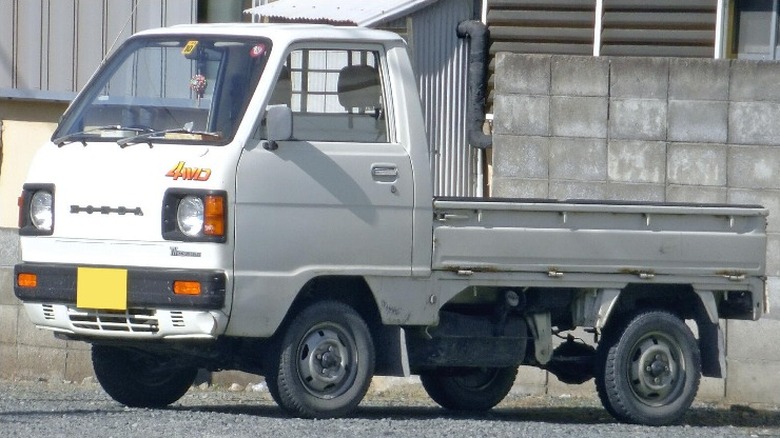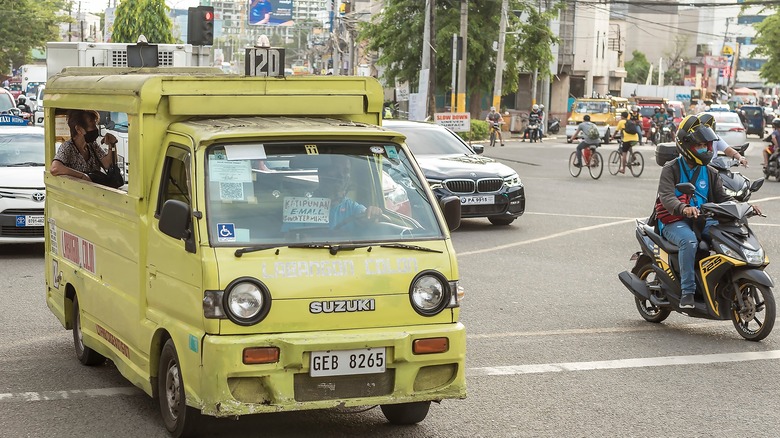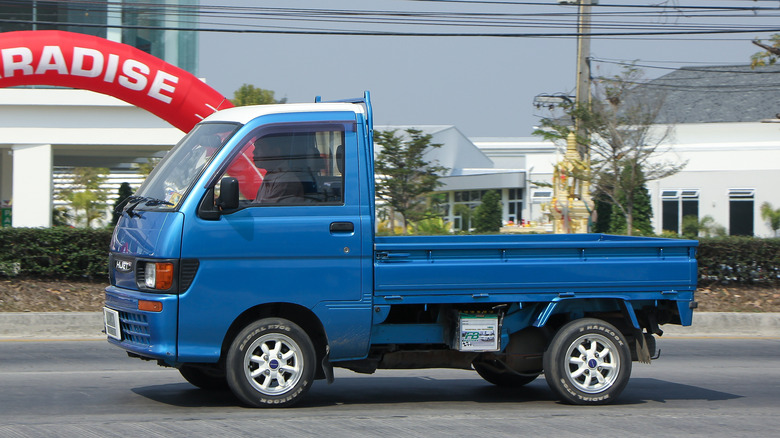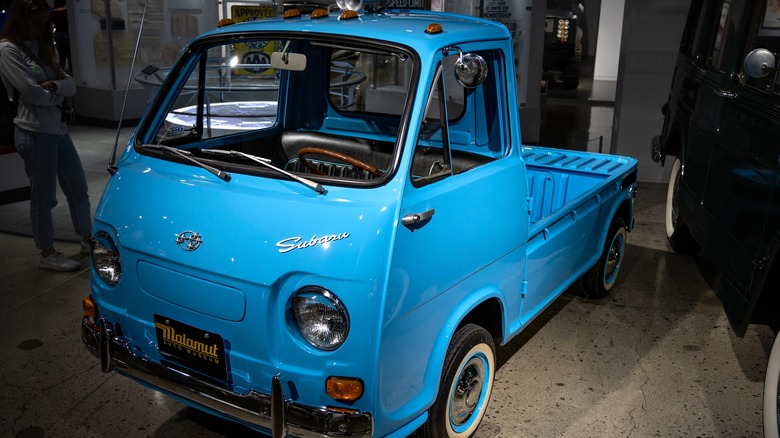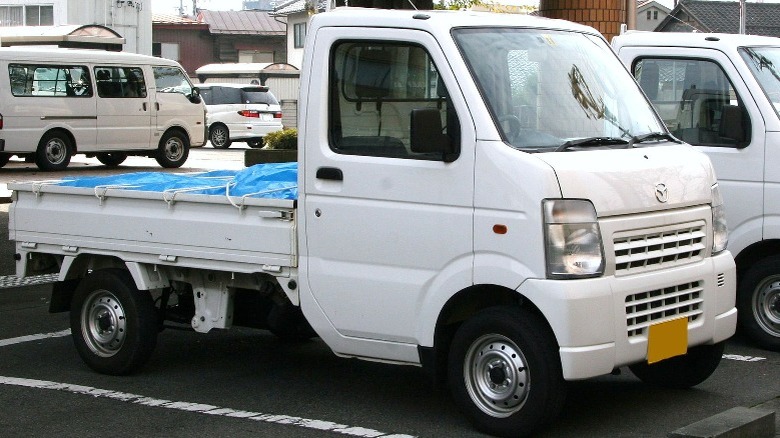5 Of The Best Japanese Kei Trucks You Can Buy
Japanese cars are everywhere on American roadways. An enormous cross-section of the best-selling cars and trucks in the United States come from Japanese manufacturers like Honda, Toyota, Nissan, and Mazda. The influence of Japanese automotive works is also seen in the very bones of the industry, which has shifted toward manufacturing techniques created by Toyota leadership in the 1950s.
But some of the most popular cars made for the Japanese Domestic Market (JDM) are almost unknown in America. Kei trucks are miniature vehicles that offer a flatbed or customized rear rig behind a shockingly small-looking passenger cabin; they're unmistakably Japanese in style. The trucks have been used as worksite transportation, farming tools, and much more throughout the years, and American drivers are taking notice of the smaller footprint trucks. A change in how American import laws treat foreign cars essentially eliminated the Toyota Hilux from the U.S. marketplace in the mid-'90s. Still, it hasn't stopped eager importers from bringing vintage Kei models over from Japan, which must be more than 25 years old to be road legal in the U.S. Vintage trucks have been a passion project for generations of auto lovers. Hence, it's no wonder that these industrious and rugged miniatures are making waves.
Reliability and a tiny footprint, both in cost and mass, make the Kei truck a fantastic addition to many garages nationwide. Here are five of the best models out there for your consideration.
Honda Acty
The Honda Acty is a massively popular Kei truck and a great place to begin discussing this unique class of vehicles. The Acty was introduced to the Japanese market in 1977 to replace the TN Series that came before it. The first generation Acty sold incredibly well, and Honda didn't substantially change the bones of the vehicle until the second generation was unveiled more than ten years later in 1988.
By 1990, the truck had incorporated the same, larger engine that many other Kei trucks utilized. In Honda's case, the Acty was gifted a new E07A three-cylinder, 656cc engine. The 1990 changes also brought an optional three-speed automatic transmission into the vehicle and a radio to make the drive a little more enjoyable. The round headlights of the 1980s models also left the front of the truck — something that many drivers would rather Honda kept on the Acty.
The Acty is a no-nonsense Kei truck built for reliability rather than comfort. Air conditioning or power steering were options, not standard. Acty models place the engine behind the cabin in a mid-engine configuration and utilize a rear-wheel drive layout. The vehicle is durable and reliable but almost certainly lacks some amenities that modern drivers take for granted in their everyday automobiles.
[Featured image by Kuha455405 via Wikimedia Commons | Cropped and scaled | CC BY-SA 3.0]
Suzuki Carry
The Suzuki Carry is a versatile Kei truck introduced in 1961. It was offered as a truck and, beginning in 1964, could be purchased as a van. The truck is no longer built, but newer models won't be much good for an American driver for many years.
The Carry has become a massive hit with the foreign marketplace, representing the second best seller among Kei trucks exported for sale outside Japan. The ninth generation is a favorite among buyers due to its relative youth compared to other models that can be legally driven on U.S. roadways. This generation of the Carry was built between 1991 and 1999, making a large segment of the trucks eligible for legal import and use in the U.S.
Starting in 1993, the wheels were enlarged to a 12-inch diameter, and disc brakes were introduced to the front wheels (in place of the existing drum brake design). The Carry can also be found in rear-wheel and four-wheel drive configurations, making it a good option for all drivers and roadway conditions.
Daihatsu Hi-Jet
Daihatsu has been a longtime player in the world of Kei trucks. The Hi-Jet first appeared in the 1960s and offers another fantastic option for importers and buyers looking to zip around town in a small yet efficient miniature truck.
The Hi-Jet's development has been a mirror image of the laws surrounding Kei trucks in Japan, with a two-stroke, 360cc engine first appearing in the initial models and subsequent expansions in size and power coming alongside changes in regulations. In 1990, the Hi-Jet received another update with the engine ballooning to a measured displacement of 660cc.
The Daihatsu Hi-Jet has a long history of enhancements and modifications incorporated directly into the truck's footprint. Factory models have often seen the addition of hydraulic dump beds, power lift gates, sealed refrigerated bed additions, and more. This means that the Daihatsu range might be the best option for a buyer seeking a specialized Kei truck that is purpose-built to accomplish niche tasks.
Subaru Sambar
The Subaru Sambar has been in production since 1961, seven years before Subaru was formally incorporated as a brand (in 1968). It's a fantastic example of a Kei truck. It remains a favorite for drivers in the JDM and foreigners looking to export miniaturized trucks from Japan to their local roadways. The Sambar was the first Kei truck to use the cabover design (with the engine beneath the passenger cabin). It utilized a rear-wheel drive as the standard drivetrain until adding an optional four-wheel drive configuration in 1980.
Fifth-generation models (1990-1998) and those that came before are all options for drivers seeking to import a Kei truck to the United States. Fifth-generation Sambars were powered by a 660cc engine that produced 54 brake horsepower. In 1994, the Sambar (including the van configuration that could seat seven) received a power boost. The three-cylinder engine was increased to a displacement measuring 1,200cc, nearly doubling its size.
Mazda Scrum
The Mazda Scrum originally appeared on the Japanese auto market as the Autozam Scrum in 1989. This makes it one of the youngest lineups in the Kei truck space and limits the volume of available inventory for those seeking to export a vintage example from Japan for use in the United States. The Scrum is powered by the same 660cc, three-cylinder engine from which the typical Kei truck derives its power.
Even though it's a relatively new addition to the marketplace, the Scrum is one of the best options among Kei trucks in Japan. It brings a comfortable interior cabin and benefits from quality power performance and a favorable fuel efficiency rating (roughly 38 and 45 miles per gallon). One feature buyers should keep in mind is that the Mazda Scrum is essentially a re-badged Suzuki Carry powered by a Suzuki engine. A choice between comparable Carry and Scrum models for an international buyer might come down to price since the vehicles are very similar in build and performance, with divergent badges acting as the primary difference between models.
[Featured image by TTTNIS via Wikimedia Commons | Cropped and Scaled | Public Domain]

